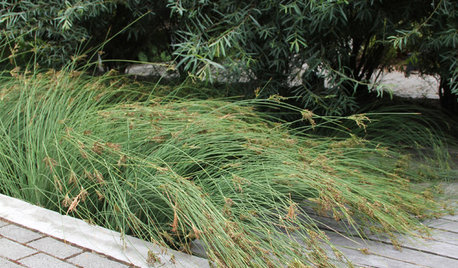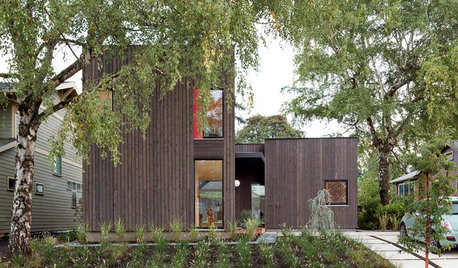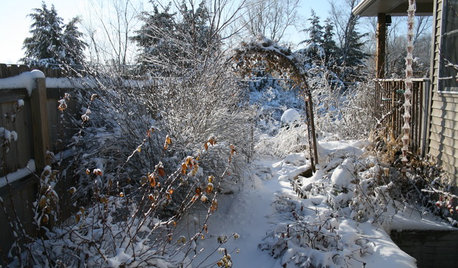Principles of rose winter protection in cold zones
nippstress - zone 5 Nebraska
10 years ago
Featured Answer
Comments (9)
jim1961 / Central Pennsylvania / Zone 6
10 years agolast modified: 9 years agotoolbelt68
10 years agolast modified: 9 years agoRelated Discussions
when to remove zone 5b winter protection?
Comments (5)If you used cardboard boxes, plastic rings, or stuff to hold the mulch in place, or Styrofoam cones with the top cut off and filled with dirt; I would get them off pronto so the mulch or dirt can breathe. This lets the ground thaw which was one of the reasons we Northeners put mulch down in the first place. It is so easy and the temptation is there to prune too early. I wouldn't worry about the mulch. We may well get another late freeze like we did last year. I plan to do a clean up of last year's leaves and try and get a head start on the weeds. Rain, if it stops snowing, will help knock down a lot of the mulch anyways so I wouldn't worry about it untill we closer to pruning time. Where are those Forsythia blooms anywho? I'm ready! Just my humble opinion. They don't call me Foghorn for nothing!...See MoreZone-pushing--no winter protection in Zone 6?
Comments (8)A few years I've left some canna tubers in the ground over the winter in zone 6 (typically varieties I wasn't very interested in saving). I think I got a good number to resprout and grow just one time (the bed was in an open location). It doesn't surprise me that people have success in a southern exposure up against the house or similar protected location in zone 6 (I've done well with Amorphophallus konjac and Nandina in such a spot). It'd also help to have exceptional drainage, and a covering of mulch would be a good idea too. I wouldn't depend on even this setting in the case of rare/expensive varieties though....See MoreLinks to hardy roses in cold zones & best roses for hot & dry climate?
Comments (30)Below is the info. that Floweraremusic (zone 5) in Washington gave on her 2020 winter-survival. She has alkaline clay with rocks at bottom like mine & less snow in winter: "My hardiest roses are the Canadians. John Davis, John Cabot, Wm. Baffin, Morden Sunrise, Morden Blush and Morden Centennial, Victorian Memory aka Isabelle Skinner, also a Canadian rose. All these only have tiny bit of tip damage and bloom a lot with no special care. Also, my Hybrid Perpetuals only have tip damage after winter. Magna Charta, Mrs. John Laing, Black Prince and Marchesa Buccella. The only negative is they don’t have long enough cutting stems. All my Austins are very hardy. The one I just can not grow is Jude. Leonardo da Vinci is super hardy and always healthy. Quietness comes through winter very well. Even Rouge Royale survives beautifully. Cinderella Fairy Tale is very hardy. Gruss an Aachen also. Ballerina and Marjorie Fair are both hardy. Poseidon, Princess Charlene de Monaco and Crazy Love didn’t do as well as I’d hoped. The surprise losses this year are Quicksilver, and Dames de Chenonceau who is left with only 1 cane. Versigny is also reduced down to almost nothing. This was a mild winter with very little snow. " Floweraremusic (zone 5). From StrawChicago (zone 5a with hard black-gumbo alkaline clay & less snow but with freezing rain in winter). Versigny didn't survive winter either. So I lost Versigny TWICE. Besides Versigny, other wimpy own-root roses that don't survive winter well: Paul Neyron, Anna's Promise, Pink Peace (own-root died 1st winter, but grafted-Pink Peace survives many winter), Elantyne, Jude the Obscure, Young Lycidas (bought as grafted-on-Dr.Huey, now with only one cane), Mary Daly, and many floribundas don't survive my zone 5a: Pink Chiffon, Sheila's perfume, King Arthur, Deep Purple, Shocking blue, Honey Bouquet (survived 1 winter). Polka Climber (survived 1 winter), Cloutilde Soupert (died twice on me). Sutter's Gold didn't survive winter, same with many fragrant mini-roses from Burlington nursery. Below are my hardy OWN-ROOT roses in my zone 5a alkaline clay, only Double Delight, Young Lycidas and Lavender Crush are grafted-on-Dr.Huey. Bold-faced are the very vigorous ones: Own-roots with 3 feet of green canes: Carding Mill (since 2012), Princess Charlene of Monaco, Duchess de Rohan, Crown Princess Magareta (since 2012), Zepherine Drouhin, Lady of Shalott, James Galway, Lavender Crush, Queen of Sweden (gave away but very hardy), Poseidon (right below the rain-spout, dug down to 2.5 feet), Scepter'd Isle (very big & hardy own-root but gave that away with its lousy scent). Own-roots with 2 feet of green canes: La Reine (many winters), Blue Mist (since 2012), Prairie Harvest (since 2014), Mary Magdalene (since 2011), Evelyn (since 2012), Radio Times (since 2011), Pat Austin (since 2011), Christopher Marlowe (since 2011), Golden Celebration (since 2011), Lilian Austin (gave away but very hardy), the Squire, the Dark Lady, Wise Portia survived 4 winters but died in poor drainage clay, Dee-lish (since 2015), Twilight Zone (since 2016), William Shakespeare. 2000 (since 2011), Comte de Chambord (since 2012), Princess Anne, Sweet Mademoiselles, Aloha climber, Orchid Romance, Bohemian Rhapsody, Marie Pavie, Lagerfeld (since 2017), Frederic Mistral survived 2 winters but died when I didn't winter-protect with leaves, Sonia Rykiel (survived 3 winters) but died in freezing rain winter, same with 1/4 of the street-trees in my neighborhood, Excellenz von Shubert (since 2013), Own-roots with less than 1 foot of green canes: Gina's rose, Tchaikosky (since 2015), Cornelia (since 2018), Bolero (few winters), Peter Mayle, Sharifa Asma, Neil Diamond, Amber Queen, A Shopshire Lad, Strike it Rich, Old Port (since 2012), Veteran's Honor (many winters), Double Delight (grafted on Dr.Huey), Savannah, Tess of d'Uberville, Gene Boerner (since 2014), thornless Yves Seedling (since 2013), Stephen big Purple (since 2012), Louise Este, Mirandy, Crimson Glory, Liv Tyler survived 1 winter but needs winter-protection, Rouge Royal (bought last year with no winter-protection). Annie L. McDowell (survived 2 winters but needs a wet-spot since it's almost thornless), Nahema (survived 1 winter then died during freezing-rain winter), same with Eyes-for-you (drought-tolerant and doesn't like freezing wet winter), Souvenir du President Lincoln, Madame Issac Pererie and Madame Earnest Calvat, Firefighter (survived 2 winters) but died since it's next to tree. Bayes Blueberry (survived many winters but I gave away), Charles Darwin (gave away since it fades badly), Arthur Bell (since 2012 & killed it since I don't like the flowers). StrawChicago....See MoreCold zone rose gardeners who don't winterize. Are grafted roses best?
Comments (16)I really have mixed feedback on this issue. I totally agree that the robust growers in cold zones do fine on their own roots and you don't have to worry about suckers from the graft. Too robust growers (like gallicas) can be better grafted so that you can plant the graft ABOVE the soil (only) for those super-hardy roses and avoid the gallica taking over the garden bed. I also agree that grafted roses of the wimpier varieties of HTs and floris are more robust in their first year or two and tend to grow bushy faster than own root versions of those plants. However, I've recently started to experience the down side of grafted HTs in a cold climate. First of all, virtually all of the grafted HTs and floris that I've planted with the graft properly buried have gone own root over time if they've survived. For instance, I bought In the Mood grafted from a local nursery and it was fabulous and bushy in its first year. The second year and for every year after that, it was a knee high one-cane wonder until it finally gave up the ghost and died after about 6 years. The same process has been happening more gradually with my grafted Savoy Hotel. It was lush (maybe 4.5' by 4.5') and incredible in its first year or two, ranking in my top 20 of roses. Every year since then it has declined and come back from the winter more slowly. By August this year, my plant in optimum sun and soil conditions has just now reached almost 3 feet with 3 canes on it and a couple of blooms here and there for the first time all season (nothing at all in June). Here's a contrast picture to show that effect - this is 2013 in June for Savoy Hotel at its full 4.5'x4.5' glory. Savoy Hotel is at the bottom right corner keeping up with Madame Isaac Periere in the back of it with no trouble. Granted, this was a particularly good rose year, but you can see the relative sizes. Now just one year later in 2014, here's Savoy Hotel in front of MIP (bottom center) also in June, and this was an average rose year for me. It's too late for MIP on the shepherd's hook to be blooming, but you can see MIP's height by the purple clematis. Notice that she's now in 2014 only 3' high and has about 4 blooms every couple of weeks. She has declined from that since, even though she's still a very nice rose. I don't have any more recent bush pictures for her since I only get the scattered blooms any more, and only late in the season to boot. One other effect I'm seeing in my older grafted roses this spring in particular is graft failure for a lot of my well-established roses with the graft well buried. Even under the soil, it seems like a grafted rose starts running out of places to grow new basal shoots after a while. For instance, this spring I lost an 8 year old Dream Come True (the tall rose at the left of the first picture) for no good reason that I could see, and it was a mild winter. Sure, you see pictures of 50 year old grafted HTs in warm climates, but those are warm climates. I suspect that if we have a 50 year old HT rose in cold climates that started out grafted and is still alive, it has gone own root in that time and is a robust rose on its own roots. My reluctant conclusions are that if a rose is going to be a wimp, it will reach that state on its own whether own root or grafted. If I get an own root HT rose through its first winter it will increase in size to its sustainable height and vigor and more or less stay there for the duration. If I get a grafted HT rose through its first winter, it will decrease in size to its sustainable height and vigor and stay there till the graft fails or it goes completely own root. There are only a few roses where I think the graft did give the rose a little boost in survival over that first winter, Memorial Day and Oklahoma come to mind, but for the most part I don't think it buys me anything in either survivability or vigor after the first year. That's why I tend to grow my HTs and floris on their own roots. I want to know the long-term height it's really going to be in its early years, I get reliable winter survival of the original rose from own roots if they get to a good size in their first year, and I don't have to dig up a massive root system when it dies or deal with suckers. Just my two cents Cynthia...See Morezaphod42
10 years agolast modified: 9 years agozaphod42
10 years agolast modified: 9 years agomichaelg
10 years agolast modified: 9 years agodublinbay z6 (KS)
10 years agolast modified: 9 years agonippstress - zone 5 Nebraska
10 years agolast modified: 9 years agosandandsun
10 years agolast modified: 9 years ago
Related Stories

HOUSEKEEPINGProtect Your House From Winter Water Damage
Avoid costly repairs by learning to spot potential problem areas before water damage is done
Full Story
GARDENING GUIDESProtect a Precious Resource With a Rain Garden
Promote pure water and a beautiful landscape with a garden design that makes the most of the rain
Full Story
WINTER GARDENINGExtend Your Growing Season With a Cold Frame in the Garden
If the sun's shining, it might be time to sow seeds under glass to transplant or harvest
Full Story
WINTER GARDENINGPruning Secrets for Exquisite Roses
Encourage gorgeous blooms year after year with this time-tested advice on how to prune your rosebush in winter for health and shape
Full Story
GARDENING GUIDES10 Cold-Hardy Succulents for Cool-Season Interest
These attractive plants shrug off colder temperatures, and many can be brought inside in containers in extra-chilly climates
Full Story
GARDENING AND LANDSCAPINGBring the Tropics to Your Cold-Climate Garden
Delightfully deceptive, these plants combine a durable nature with a tropical look to add a touch of the exotic to cooler landscapes
Full Story
GARDENING AND LANDSCAPING10 Great Outdoor Chill Zones
Whether you have a huge poolside deck or a sliver of a patio, these ideas will kick stress to the curb all summer long
Full Story
GREEN BUILDINGHouzz Tour: Passive House Principles, Active Benefits in Portland
Lower energy bills and consistent temperatures are just two of the advantages of this architect’s newly built home
Full Story
LIFE6 Ways to Beat the Winter Blahs
Snow and dark days dampening your spirits? These ideas will have you looking on the bright side
Full Story
GARDENING GUIDESGarden Myths to Debunk as You Dig This Fall and Rest Over Winter
Termites hate wood mulch, don’t amend soil for trees, avoid gravel in planters — and more nuggets of garden wisdom
Full Story



seil zone 6b MI